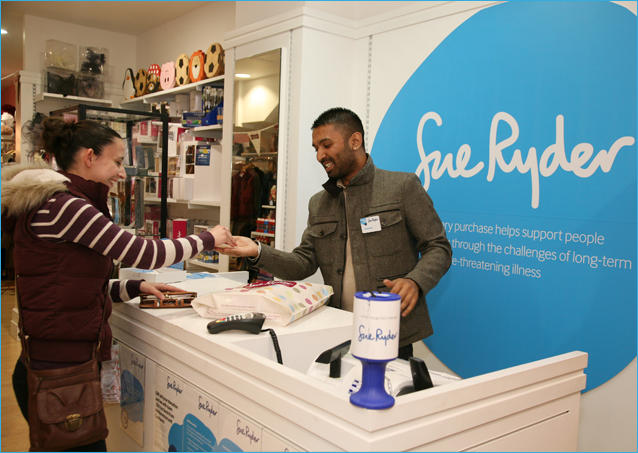
Katy Faulkner and Keren Caird explain how it all starts with a thank you, and why using Retail Gift Aid has changed the way they interact with donors.
Gift Aid is a tax-efficient form of giving which adds approximately 25 per cent to the value of gifts to charities. Traditionally, it had been restricted to cash donations. In 2006, Sue Ryder was the first charity to establish a revolutionary way of applying the same principles to donated items (which account for 80 per cent of the charity’s sales).
The charity now runs the scheme throughout all 430 of its shops nationwide, securing millions of pounds in extra income each year.
Engaging with potential Gift Aid donors
For the charity to claim the Gift Aid, all that is required is signed permission from the person donating the goods. When a donor brings items into the shop, after being thanked, they will be asked if they have a donor ID number. If the answer is no, then they are asked if they would like to register as a Gift Aid donor.
There is a set of terms and conditions, which the donor is made aware of before signing the donor declaration form. Once a form is signed, the donor is given a donor ID card containing their unique donor ID number for future donations to Sue Ryder shops.
In order to ensure our shops take full advantage of the scheme, we give full training in Retail Gift Aid to all shop staff and volunteers, and we provide regular refresher training/in-house promotional campaigns in order to continually improve performance.
Capturing data and maintaining relationships
As well as providing us with extra money, the Retail Gift Aid scheme enables us to capture our charity shop donors’ details. This means we can stay in regular contact with them, keep them up to date with the incredible care provided by the charity, and let them know our plans for future development.
Since introducing the scheme, we’ve built a database of over 700,000 Retail Gift Aid donors.
This database also monitors donation habits and trends. By understanding who our donors are, we can tailor our PR and marketing accordingly, thereby maximising response rates.
Historically, customers have been informed of how much their donation has raised by letter. Recently, Sue Ryder has started sending these notifications by email where a donor has provided their details – this has significantly reduced the costs of administering the scheme.
The next development is to send a ‘thank you for registering as a Gift Aid donor’ email to new donors that provide an email address, and a thank you email each time that they donate items. This will help to engage with donors and encourage them to continue to bring their unwanted items to Sue Ryder.
The future of Retail Gift Aid
In 2012, HMRC announced new guidance for Retail Gift Aid to significantly simplify the administration processes for large and small organisations, making the scheme even more attractive for charities to take up.
Once shop teams understand the simplicity of the scheme and can communicate it to their donors, charities can unlock additional income for their cause – a change well worth investing in.
Katy Faulkner is the head of retail for business development and Keren Caird is retail gift aid development manager at Sue Ryder.
If you liked this article and would like to find out more about using gift aid in a charity shop then you may be interested in also reading our guide to charity shops and Gift Aid




